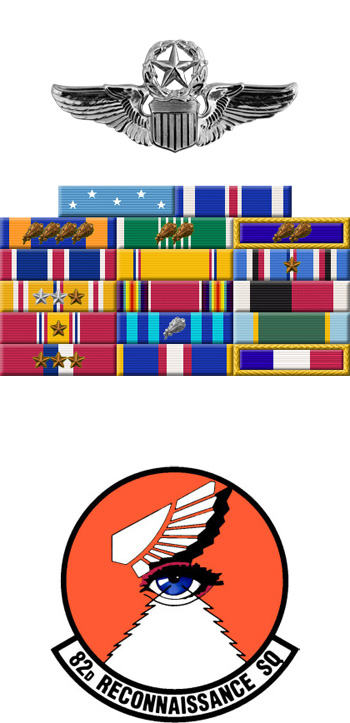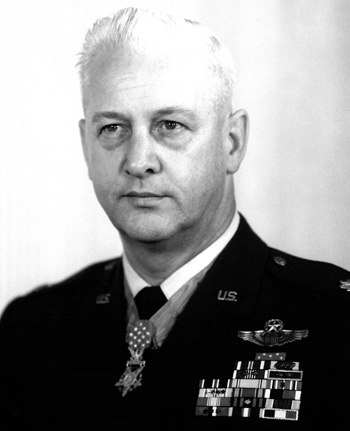
|
William A. Shomo |
 |
|||
| Rank, Service | ||||
Lieutenant Colonel O-5, U.S. Air Force |
||||
| Veteran of: | ||||
|
||||
| Tribute: | ||||
Bill Shomo was born on May 30, 1918, in Jeanette, Pennsylvania. He attended the Cincinnati College of Embalming and the Pittsburgh School of Embalming between 1937 and 1940, and then he worked as a mortician for a short time before enlisting in the Aviation Cadet Program of the U.S. Army Air Forces on August 18, 1941. After completing pilot training, Shomo was commissioned a 2d Lt and awarded his pilot wings on March 7, 1942. He served as a pilot at air fields in Louisiana, Georgia, and Texas, before being sent to the Southwest Pacific Area, where he served with the 82nd Tactical Reconnaissance Squadron from June 1944 to October 1945. During this period, Maj Shomo flew 203 combat missions, was credited with the destruction of 8 enemy aircraft in aerial combat plus an additional 19 on the ground while strafing Japanese airfields, and was awarded the Medal of Honor for destroying 7 enemy aircraft during one combat mission on January 11, 1945. After returning to the United States, Shomo served with the 1060th Army Air Base Unit at Greensboro, North Carolina, and then the 999th Army Air Forces Base Unit at Orlando, Florida. He left active duty on May 18, 1946, and served with the 146th Fighter Squadron of the Pennsylvania Air National Guard until he returned to active duty on July 21, 1947. Shomo served as Chief of the Flight Operations Branch with Headquarters Strategic Air Command at Andrews AFB, Maryland, from July 1947 to July 1948, and then attended Air Command and Staff School at Maxwell AFB, Alabama, from July to December 1948. From January 1949 to February 1951, Col Shomo served as Deputy Director of Operations for the 561st Fighter Wing at Selfridge AFB, Michigan. His next assignment was as assistant chief of the Operations Division with Headquarters Air Defense Command at Ent AFB, Colorado, from February 1951 to March 1952. He served with the 175th Fighter-Interceptor Squadron at Rapid City AFB, South Dakota, from March to December 1952, and then served as Director of Combat Operations with Headquarters 31st Air Division at St. Paul, Minnesota, from December 1952 to October 1953. Col Shomo next commanded the 14th Fighter-Interceptor Squadron at Sioux City AFB, Iowa, from November 1953 to December 1954. After completing F-89 Scorpion combat crew training, he served as commander of the 59th Fighter-Interceptor Squadron at Goose Bay, Labrador, from January 1955 to July 1957. Shomo was then assigned as commander of the 54th Fighter Group at the Greater Pittsburgh Airport, Pennsylvania, from July 1957 to January 1958, followed by service as Executive Officer for the 79th Fighter Group at Youngstown Municipal Airport, Ohio, from January 1958 to December 1959. He then served as Executive Officer and then Director of Operations for the 4601st Support Wing at Paramus, New Jersey, from December 1959 to July 1962. Col Shomo next served as an Operations Staff Officer and Deputy Commander for Operations of the 551st Airborne Early Warning and Control Wing, flying the EC-121H Warning Star AWACS platform at Otis AFB, Massachusetts, from July 1962 to February 1964. He served as Deputy Commander for Operations of the 4683rd Air Defense Wing at Thule AB, Greenland, from February 1964 to March 1965, followed by his final assignment as Executive Officer of the 325th Fighter Wing at McChord AFB, Washington, from March 1965 until his retirement from the Air Force on October 1, 1968. Bill Shomo died on June 25, 1990. |
||||
|
||||

